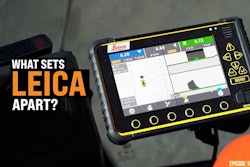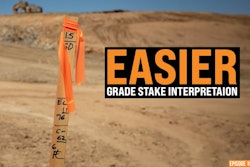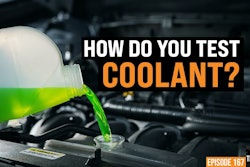So you want your compact track loader to act like a dozer?
There’s an attachment for that, and it’s completely wireless. On this episode of The Dirt, Terrawise machine control specialist Robbie Luman reveals the TerraBlade. The 8-foot-wide blade can handle dozer and grading chores in 3D, 2D or even no machine control.
It works on CTLs with at least 75 horsepower and optimally runs on 90-plus-horsepower loaders. Because it’s wireless, it can be transferred easily and quickly to other CTLs.
The heavy-duty attachment has several material-carry modes, including as a six-way dozer blade, box blade or catch and spill applications. Operators can independently raise and lower the left and right sides and rotate the blade up to 25 degrees. The foldable wings swing up to 270 degrees. The adjustable skid plate is designed for quick and precise operation.
So to find out how you can doze and grade with your CTL, check out the latest episode of The Dirt.
Equipment World serves up weekly videos on the latest in construction equipment, work trucks and pickup trucks – everything contractors need to get their work done. Subscribe and visit us at equipmentworld.com!
In This Episode:
- 00:00 – Terrawise TerraBlade
- 00:45 – What is the TerraBlade?
- 01:29 – Can You Accurately Grade with the TerraBlade?
- 02:55 – Can You Use the TerraBlade Without Machine Control?
- 03:55 – How Easy is it to Attach and Remove the TerraBlade?
- 05:20 – Does the TerraBlade Work on Any Compact Track Loader?
- 08:52 – What Kind of Hydraulic Flow is Needed for the TerraBlade?
- 09:10 – What Size Machine Can Use This Attachment?
- 10:03 – Will This Attachment Break Easily?
- 10:44 – How to Find Out More About the TerraBlade
Video Transcript:
Bryan Furnace (00:00):
Today we're here to talk about some skid steer blades. These are pretty versatile attachments. And as you may have noticed here in the last four or five years, there have been quite a few manufacturers that are coming online with these dozer blades and I've always been very skeptical about the success of the dozer blades. But as we're starting to see designs change, these are actually becoming pretty handy tools to have on a job site. Today we're here to talk about Terrawise and their blade and joining us today from Terrawise is Robbie. So for the audience, can you kind of give them an overview of the Terrawise Blade?
Robbie Luman (00:52):
Yeah, so our Terra Blade Skid Steer Implement eight foot wide greater slash dozer blade. We've got two foot wings on both sides. For dual wing catch and spill, you got 25 degrees of rotation, mainly just for your heavy civil guys and then also for your guys that are in tight-knit areas. So just kind of an all-around attachment that you can use, whether it's 2D or 3D implements. For machine control purposes, we're just using the attachment in its raw state. No machine control at all. We've got 3000 pounds on the implement, but we use a foot design to combat anything with the weight out front.
Bryan Furnace (01:28):
And so one of my big questions, my big hangup with all of the skid steer blade attachments up until recently have been the boom arm float. I mean you still get some movement in those boom arms and so it's really difficult to translate to a really accurate grade on the ground. How do you guys deal with this problem?
Robbie Luman (01:46):
Yeah, so I just mentioned that foot in the rear. So you've got skid steer and then where it actually quick attaches and then just in front of that is an actual heel or a foot or skid plate, however you want to name it. But that plate is where your pressure is set. So with the other manufacturers, whether it's with stabilizing wheels out in front to combat that or nothing at all, we're able to utilize our design to put the pressure down so that back and forth rock that you'll get with the short track length of a skid steer, that's all taken care of with that design. So without the wheels out front, that's allowing us to be able to get into tight corners, attack a stockpile. So if a customer's got a pile of GAB or a pile of dirt and they need to actually close up those wings and turn it into a box blade, they can go right into it with the side of the blade, grab some material and keep carrying it on across the site. So we don't have to worry about any of those issues. Also keeps it more compact, so if wheels out front, you can now have a larger attachment for still a relatively small blade quote.
Bryan Furnace (02:53):
Gotcha. And so I guess kind of touching back to the machine control side, this I'm assuming like most of these style of blades really shines when you have some sort of machine control coupled along with it. But that being said, you can run it without machine control.
Robbie Luman (03:11):
You certainly can. Yeah, and most applications we still are able to utilize the joystick controls on most manufacturer skid steers. So you still get your independent lift lift cylinder style like a motor grader where we can independently control the lift and lowering the blade. We do have an external remote that will be mounted inside the cab of the machine that can take care of your rotation in your wings and then also for your lift as well. So you can still run it kind of in the sense of just a normal implement without any kind of machine control. Obviously utilizing machine control for other things is how you speed up and increase efficiency, but it is a possibility to run it that way. I've got several people that do that. So
Bryan Furnace (03:54):
Now let's get into the versatility of the attachment. Is this something where I'm going to hard plum hardwire this thing on and that's going to be a dedicated attachment for that dedicated skid steer? Or is this something that I can switch around to machine to machine to machine? Yeah,
Robbie Luman (04:08):
You certainly can. So the way our implement is set up currently, we kind of have two different ways to go, but the main one that everybody's going with is our 100% wireless setup. So no wires running through anybody's machines at all. With normal machine control systems, whether you're talking about an integrated system or an aftermarket system, there are cables and sensors ran throughout the machine itself, but with the skid steer implement, we're able to keep everything out on the blade. You can actually do what's B and C, so we can actually mirror the image from the panel, bring it inside the cab. So you have an external, say like an iPad or an Android tablet, even your cell phone can do it as long as it can hook to Wi-Fi. We can mirror cast that actual machine control panel from the attachment now into the cab. So as far as unhooking from the Skid-steer say, alright, I've graded this parking lot, but now I need to use my skid-steer to load some material in the back of a dump trailer. I can disconnect my hydraulic lines, unplug the power cable and put my bucket on and I'm good to go. And then vice versa, when I'm ready to hook back up to the system, plug in my hydraulics, plug in my power and I'm back up and going.
Bryan Furnace (05:20):
And so that's kind of covering the skids steer side. On the attachment side. I'm assuming since you guys, unless you actually hardwired in and you choose to go that route, I'm assuming I could take this and go throw it on my other skids steer with no problem since everything's kind of external to the machine.
Robbie Luman (07:27):
Correct. So the only thing is as long as you're on the same manufacturer of Skid steers, so with our power cable, we custom make that for whatever our customer's skid steer is. Just for example, I've got a customer that bought a tear trimmer from us, which is another implement, but same design, hydraulic lines and a power cable. It's wireless as well. And he didn't want to have to mobilize an entire skid steer and attachment because that weights that requires a CDL to move heavier grade trailer. It's expensive all the way around and he works all over the southeast. So he is moving state to state. So when it comes to jumping around from project to project where this implement is very niche, he's going to send it to this project where it's needed, get the job done, and then immediately be able to just trailer the implement to the next job. So he actually rents skid steers wherever that job is at so he can save on cost. He doesn't own the equipment, so all he is paying for is the rental price and some fuel and he's rocking and rolling, no problem. And also just keeping the cost of his operations down.
Bryan Furnace (08:32):
Yeah, interesting. So really his only asset is the attachment itself, the machine. He's just picking up wherever he's gone. That's right. Very interesting.
Robbie Luman (08:40):
That's right. He just goes, so for his case, he's renting a CAT 299 skid steer. So every time whatever state he's in, he just rents a Cat 299 brings the implement and it plugs right in.
Bryan Furnace (08:51):
Nice. So what kind of hydraulic flow is required for this attachment? I'm assuming you don't need any sort of high flow.
Robbie Luman (08:59):
Nope, nope. No high flow needed for our attachment. We just turn on constant flow for the hydraulics and we're rocking and rolling.
Bryan Furnace (09:06):
Gotcha. And then my final question for you is, I'm assuming this is a pretty beefy attachment since you're throwing an actual dozer blade out there. What size machine would you really recommend for this thing to shine
Robbie Luman (09:20):
With? Skid steers, anybody that's been around a skid steer understands that there are limitations to power. It's not an actual dozer, it's not a motor grader, it is a compact solution. That's the whole idea. And with this blade, we're able to maximize the usage of the compact, but when it comes to power rating, we really rate it no less than 75 horsepower. But if you really want to be able to use a blade to its full potential, you want to be in a 90 plus horsepower machine, ideally like a CAT 299 or John Deere 330G or something of those sorts.
Bryan Furnace (09:53):
Something that's got some oomph behind it.
Robbie Luman (09:55):
That's right. It's got to have a little bit of get up and go. You want to be able to cut down into the dirt a little bit. That's what you're going to need.
Bryan Furnace (10:01):
Yeah. So now I'm going to ask the question that I think all operators are wondering if I have a triaxle dump truck, put a big old pile on the ground, is this thing going to have the beefiness that I can go knock that pile down before I start grading? Or do I have to be pretty delicate with this thing?
Robbie Luman (10:18):
No, absolutely. You cannot hurt this attachment. You go head full on right into that pile of material and it's going to carry it out. That implement is stronger than that skid steer can really push. So that skid steer is going to stop and run out of power before you hurt that implement. Nice. It's a hundred percent USA made steel, everything manufactured in the United States, so it's large and in charge. I'll put it that way.
Bryan Furnace (10:43):
Yeah. Excellent. So people want to find out more information about this blade. What's the best way to get some more literature or just watch some videos of it.
Robbie Luman (10:51):
So we got plenty of information, some good pictures and literature. Also some link to videos on our website, Terrawise solutions.com or you can look us up on LinkedIn as well. We've got several good links to some videos on there. YouTube channel, you name it.
Bryan Furnace (11:06):
Awesome. Well Robbie, thank you so much for the information. I appreciate it, man.
Robbie Luman (11:10):
Absolutely. Thank you Brian.










